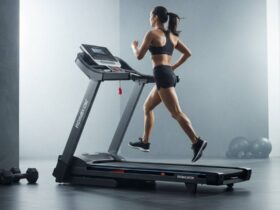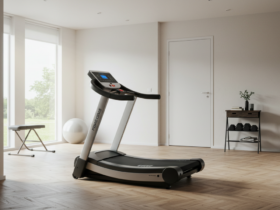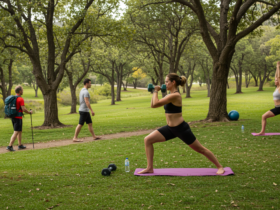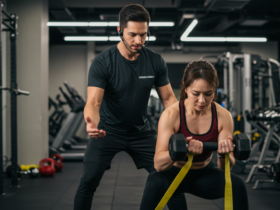Intro of How to choose the right treadmill for your home gym
When it comes to improving your fitness and maintaining an active lifestyle, investing in a treadmill for your home gym is one of the best decisions you can make.
Whether you’re a runner or a casual walker, having a treadmill at home gives you the flexibility to workout whenever you want. But choosing the right treadmill can be overwhelming with so many options available.
In this guide, I’ll help you navigate the process of selecting the perfect treadmill for home use by breaking down everything you need to consider: from fitness goals to key features, and even space considerations. By the end of this guide, you’ll know exactly what to look for when you’re ready to make a purchase.
Define Your Fitness Goals
Before you rush into buying a treadmill, take a moment to reflect on your fitness goals. Your specific goals will influence the type of treadmill that will work best for you. Here are some questions to ask yourself:
Are You Walking, Running, or Doing Both?
If you plan on walking, a manual treadmill or a low-power motorized treadmill might be all you need. However, if running is your focus, you’ll want to choose a treadmill with a more powerful motor, an adjustable incline, and a sturdy frame.
What Is Your Desired Intensity?
If your goal is to lose weight or improve cardiovascular health, you’ll want to find a treadmill with adjustable incline to simulate hill training. High-intensity workouts require a treadmill with more features like higher speeds and customizable workout programs.
How Often Will You Use It?
For someone who plans to use the treadmill daily, it’s essential to invest in a higher-quality treadmill to ensure durability. If your usage will be occasional, a basic home treadmill may suffice.
By understanding your fitness goals, you’ll be better equipped to choose a treadmill that meets your needs. Now, let’s move on to choosing the right type of treadmill for your home gym.
Consider the Space Available in Your Home Gym
When selecting the right treadmill for your home gym, one of the most crucial aspects to consider is the amount of available space. Treadmills come in various sizes, and choosing one that fits comfortably in your space is essential for both your workout experience and safety.
Measure Your Space
Before purchasing a treadmill, measure the area where you plan to place it. This is especially important if you have limited space or are setting up a treadmill in a small room or apartment. Precise measurements will help ensure that the treadmill fits comfortably without crowding the space.
Treadmill Dimensions
The average treadmill size typically ranges from 60 to 80 inches in length and 30 to 40 inches in width. Some models may be even larger, especially commercial treadmills designed for heavy use. The length is particularly important, as it determines the running surface, so ensure the treadmill will have adequate space for you to stride comfortably.
Height and Clearance
Keep in mind the height of the treadmill, particularly the headroom needed to walk or run safely. Most electric treadmills and folding treadmills will be at least 50 inches tall, but this can vary by model. Make sure you have sufficient ceiling clearance to avoid bumping your head during use.
Safety Space
It’s essential to leave extra space around the treadmill. This space ensures that you have room to safely step on and off, and it also helps maintain airflow and ease of movement. Ideally, leave 2–3 feet of clearance on all sides of the treadmill.
Extra Considerations
If you plan to use the treadmill in a shared space or want to have a workout area around the treadmill for stretching, strength exercises, or other fitness routines, make sure the area can accommodate these activities as well. This is particularly important if you are setting up a home gym with multiple types of fitness equipment.
Folding vs. Non-Folding Treadmills
Once you have a good idea of the space dimensions, it’s time to think about whether you need a folding treadmill or a non-folding treadmill. Each has its own advantages, depending on your space and usage preferences.
Folding Treadmills
If space-saving is a priority, a folding treadmill is a great option for those with smaller spaces. These treadmills have a folding mechanism that allows you to easily store the treadmill upright when not in use, making them ideal for apartments, smaller rooms, or multi-use spaces.
Storage Flexibility
The key advantage of a folding treadmill is that it can be stored away easily when not in use. This is perfect for individuals who need to reclaim floor space after a workout session.
Size Considerations
While folding treadmills are compact, they tend to be smaller in size and may not have all the features of their larger, non-folding counterparts. That said, high-quality folding treadmills are available with robust features such as adjustable speed, incline, and cushioning, making them suitable for both walkers and runners.
Ease of Use
Check that the folding mechanism is easy to operate. Some folding treadmills require significant effort to fold, while others have hydraulic or assisted systems that make the process smoother. Look for a treadmill with a secure locking system to prevent any accidents when storing the treadmill.
Non-Folding Treadmills
For those with enough space in their home gym and who don’t mind having a treadmill that stays in place, non-folding treadmills offer durability and stability. These models are designed for more frequent or intense use, making them suitable for individuals who plan to run regularly or need a more permanent setup.
Durability
Non-folding treadmills are typically more robust and built for heavy-duty use. They feature stronger frames, longer running decks, and more powerful motors, which makes them ideal for both running and walking at high speeds or inclines.
Stability
Because non-folding treadmills are heavier and more solid, they offer better stability during workouts. This is especially important for high-speed running, where stability and safety are paramount.
Space Considerations
Non-folding treadmills tend to take up more space compared to folding models. Be sure that your home gym or workout area has enough room to accommodate the larger footprint of these treadmills, especially when considering how much space is required for safe use.
Additional Space Considerations for Your Home Gym
When deciding where to place your treadmill in your home gym, it’s not just about the treadmill’s size. You should also think about the overall environment you’re creating and how your treadmill will fit into that space.
Room Flow and Layout
In addition to considering the treadmill’s dimensions, make sure that the treadmill will be in a space where you can move freely. Ensure there’s enough room to walk around the treadmill and access other parts of your gym or home. It’s also important to think about any other fitness equipment you plan to use and ensure that your treadmill doesn’t obstruct the flow of your workout.
Ventilation and Lighting
When setting up your treadmill, ensure there’s adequate ventilation. Treadmills can generate heat, especially during intense workouts, so good airflow will help make your workout more comfortable. Natural light or bright artificial lighting will enhance the workout experience and keep you energized during your sessions.
Noise and Vibration Control
Treadmills can create noise, particularly the motor and belt movement. If you’re placing the treadmill in a shared space, like an apartment or a room near others, noise reduction will be important. You may want to consider placing the treadmill on a mat to absorb sound and vibrations, reducing the impact on floors and minimizing noise.
Additionally, some treadmills come with features designed to reduce noise during operation. If you’re sensitive to noise or don’t want to disturb others, look for a model with quieter motors and low-impact running surfaces.
Power Supply
Lastly, don’t forget about the power requirements for your treadmill. Many electric treadmills require a standard power outlet, but high-end models or commercial-grade treadmills may require a dedicated circuit. Be sure to check the power requirements of the treadmill and ensure there’s a nearby electrical outlet.
Choose the Right Type of Treadmill
Now that you’ve assessed your fitness goals and available space, it’s time to look at the different types of treadmills available. Each type has its pros and cons depending on your needs.
Manual Treadmills
- Pros: Low price, no motor, great for walking.
- Cons: Harder to use for running, limited features.
A manual treadmill is a basic option, and while it’s often cheaper, it requires more effort to move the belt. This can be ideal for those who are looking for a light workout or prefer walking at a steady pace.
Electric Treadmills
- Pros: Adjustable speed, incline, and various workout programs.
- Cons: More expensive than manual models, require more maintenance.
An electric treadmill comes with a motor that powers the belt, making it easier for you to run or walk at different speeds. If you plan to run regularly or incorporate interval training into your workout, this is the best option for you.
Commercial Treadmills
- Pros: High durability, more powerful motor, great for heavy usage.
- Cons: Expensive, large and heavy.
If you’re looking for a professional treadmill that can withstand daily, intense workouts, a commercial treadmill might be the best choice. These treadmills are designed for commercial use but are great for home gyms as well.
Evaluate the Key Features
Choosing the right treadmill depends on several important features that affect your workout experience. Here are some of the key features to consider:
Motor Power
The motor power of a treadmill is measured in horsepower (HP). For walking or light jogging, a motor with 2.0 HP is sufficient. However, if you plan to run at high speeds regularly, you should look for a treadmill with at least 3.0 HP to ensure smooth operation.
Speed and Incline
- Speed: Most treadmills offer a speed range between 0–12 mph. The higher the top speed, the better suited the treadmill is for runners.
- Incline: An adjustable incline feature is essential for simulating hill workouts and increasing the intensity of your training.
Shock Absorption and Cushioning
If you plan to use the treadmill for running, it’s vital to choose one with excellent shock absorption systems. A treadmill with good cushioning can help reduce the impact on your joints, making it more comfortable to run or walk.
Treadmill Deck and Running Surface
The treadmill deck should have a smooth, spacious running surface. For taller users or those with a long stride, look for a running surface that is at least 55 inches long. Quality treadmills have wider decks, which provide more stability and comfort during your workouts.
You san also read Where to buy New Era baseball hats
Additional Features to Look for
Modern treadmills offer a variety of additional features that can improve your workout experience.
Heart Rate Monitor
A heart rate monitor is crucial for tracking your fitness and staying within your target heart rate zone. Some treadmills come with a chest strap or hand grip sensors that measure your heart rate during your workout.
Console and Display
Look for a treadmill with a user-friendly console and a clear display. Features like preset workout programs, customizable workouts, and built-in speakers can help you stay engaged during your workout.
Entertainment Features
Some treadmills come with built-in speakers, Bluetooth compatibility, or fitness apps to make your workout more enjoyable. These entertainment features can make running on a treadmill less monotonous.
Durability and Warranty
When purchasing a treadmill, durability is an important factor. If you plan to use the treadmill frequently, make sure you choose one with a solid frame and a long-lasting motor.
Warranty
Check the warranty offered by the manufacturer. Most treadmills come with a warranty covering the motor and frame for at least 5 years. Some brands offer lifetime warranties, which is a good indicator of quality.
Test the Treadmill in Person
It’s always a good idea to try out a treadmill in person before making your purchase. This will help you assess its comfort, stability, and ease of use.
What to Look for When Testing a Treadmill:
- Noise: Ensure the treadmill operates quietly, especially if you plan to use it in a shared space.
- Stability: The treadmill should feel solid and not wobbly when you walk or run.
- Control Ease: Test the console to ensure the buttons and controls are intuitive and easy to use.
Read Reviews and Compare Prices
Before finalizing your decision, take some time to read treadmill reviews from other users. Real-life experiences can provide insights into the long-term performance and reliability of the treadmill.
Additionally, compare prices from different stores, as treadmills often go on sale. You might find a great deal on a high-quality treadmill by waiting for a promotion or discount.
My Opinion| How to choose the right treadmill for your home gym
Choosing the right treadmill for your home gym doesn’t have to be complicated. By considering your fitness goals, evaluating important features, and factoring in your available space, you can find a treadmill that meets your needs. Whether you’re walking, running, or training for a marathon, the right treadmill will help you achieve your fitness goals.
Remember to invest in a high-quality treadmill that’s durable, reliable, and comfortable for your specific workout needs. Happy treadmill shopping, and good luck on your fitness journey!

















Leave a Reply
View Comments